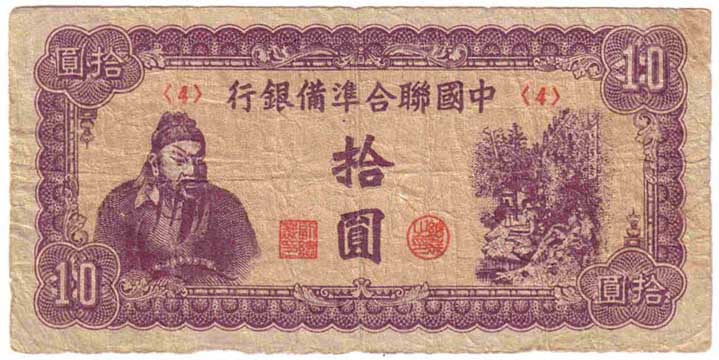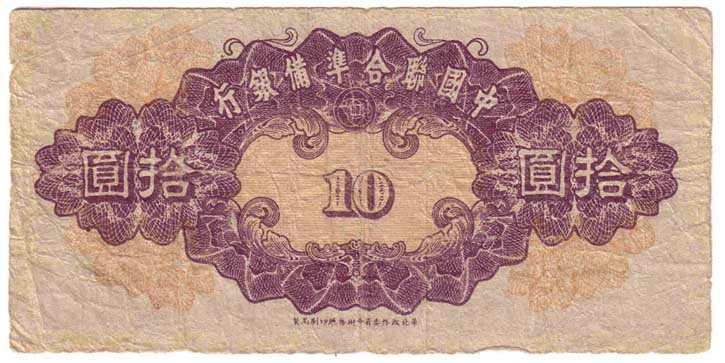Federal Reserve Bank of China
中國聯合準備銀行
[Chung Kuo Lien Ho Chun Pei Yin Hang]
|
The United Reserve Bank of China was established in Peking on 10th March 1938. It was closed at the end of the war in 1945. Below is the more detail about the bank from the book 'A History of Chinese Currency': The bank notes of the United Reserve Bank of China had 45 face values from half fen to 5000 yuan, with designs of the Stone Bridge, the Temple of Heaven and the Great Wall as well as portraits of 關羽 Guan Yu (or Kuan Yu), 岳飛 Yue Fei (or Yueh Fei), Mencius, Confucius and Yao (a legendary monarch in ancient China). They were circulated in Hebei, Shanxi, Shandong and Henan Provinces. The bank, controlled by Japanese banks, encouraged runaway inflation. "孔子對天壇,伍佰當一圓。" [Confucius facing the Temple of Heaven, five hundred yuan is worth one yuan.] This folk rhyme then prevailing in Beijing (Peking) gave expression to the popular discontent with the devaluation of bank notes issued by the United Reserve Bank of China. |
Marks of Rareness of the Collected Currencies
Extremely Rare A ~ Very Rare B ~ Rare C ~ Not So Many D ~ Common E
| Issue Evolution and Peculiarity No.: 379 Size : 70mmx144mm Denomination : 10 Yuan Issued by : The United Reserve Bank of China in 1944 Rareness : E Obverse |
 |
| The portrait appears on the obverse is 關羽 Kuan Yu or Guan YU, his courtesy name was Yun Chang 雲長 was a general of the State Shu in the Three Kingdoms Period (AD220 - AD280). He used a broad sword as weapon [known as Kuan Tao 關刀]. After his death, Chinese respects him because he symbolizes the royalty to his country and friends. He was posthumously known as Guan Gong 關公 by the children, He was probably one of the most respected men in the ancient China. Temples were built to worship him. Practically all Chinese emperors in later dynasties revered him as the Emperor Guan 關帝 or God of War, for a variety of reasons. A very comman practice in Hong Kong, a shrine for Guan Gong is located in each police station. Most Chinese policemen pay respect to him. |
| Reverse |
 |
By courtesy of Mr. JT Talbot
To view other Notes
No.117, or No.118 and or No.119.
The Key Dates of Renminbi Aluminum Coin